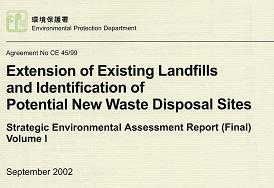Part III : How to Conduct SEA?

http://www.epd.gov.hk/epd/english/environmentinhk/eia_planning/sea/waste_disposal_sites.html
The purpose of the study is to identify both possible extensions to the existing landfills and new sites for waste disposal so that replacement landfills can be planned, developed and opened ready to accept waste.
The SEA process avoided a number of environmentally sensitive sites and identified insurmountable ecological problems by ruling them out during the site selection process. Also, the SEA formed as one key element of an evolving waste management strategy for Hong Kong. The study process allowed numerous important issues or considerations to be looked into at an early stage and therefore allowed the decision makers and stakeholders to have a better overall picture.
| |
| SEA of Landfills Extension Study – Key Points
- An investigation to identify new landfill sites and extension of landfills.
- Identifying “Areas of Absolute Exclusion”.
- Constraints mapping: environmental, ecological, conservation etc.
- 15 sites were identified for assessment.
- Identified insurmountable environmental problems.
- Discussed the environmental implications of the selected sites.
- Recommended preferred sites and suitable sites for further investigations.
- Proposed a SEM&A programme.
|

|
| SEA of Landfills Extension Study – Key Outcomes
- The South Cheung Chau is identified as the environmentally preferable site.
- The site is within the current dumping ground, i.e. limited ecological value.
- Minimal far field water quality impacts and the overall changes in flow discharges through the major water channels would be within 0.1%.
- Hydrodynamic changes are unlikely to affect any significant marine ecological resources.
|
|
|

